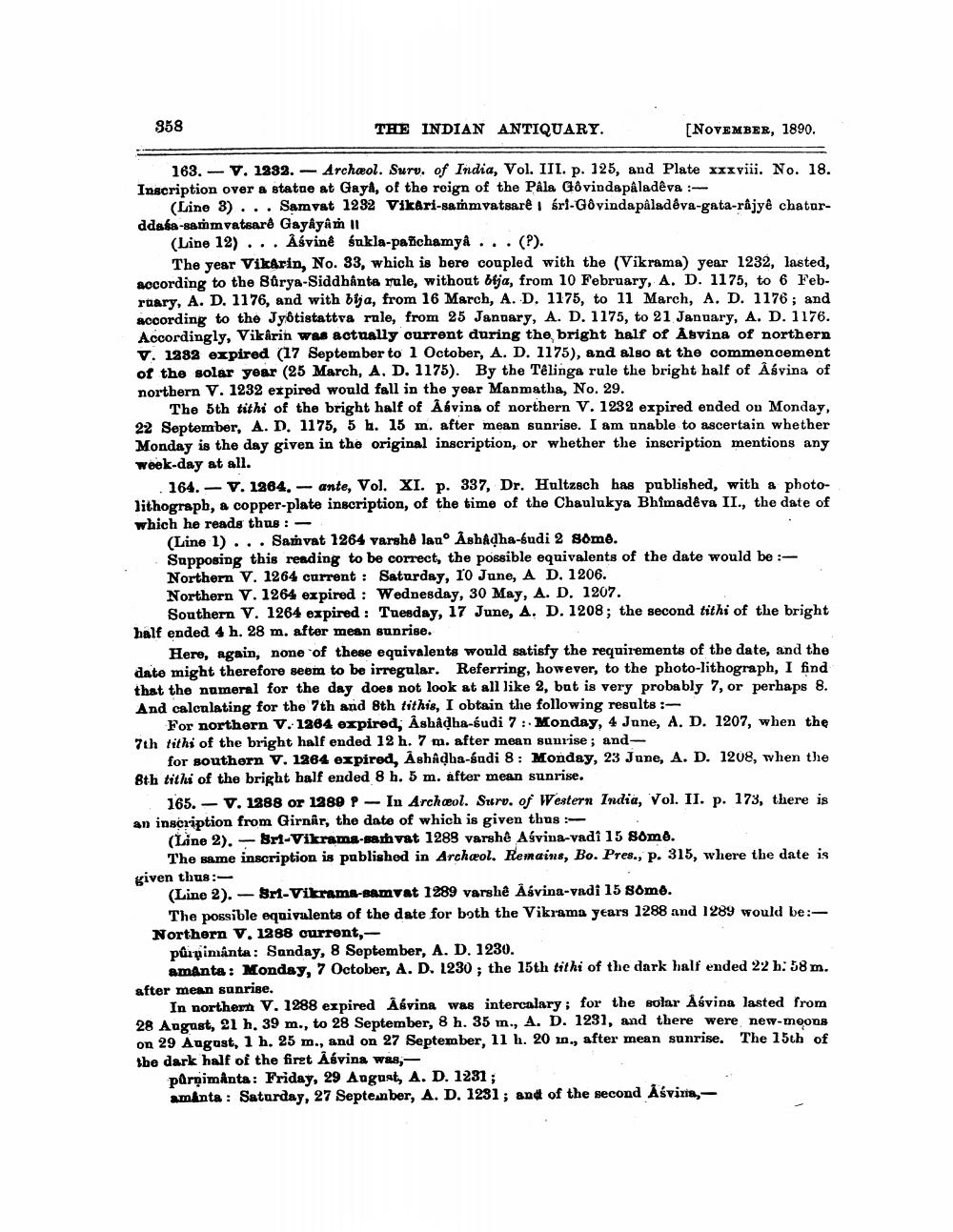________________
858
THE INDIAN ANTIQUARY.
[NOVEMBER, 1890.
163.- V. 1992. - Archæol. Surv. of India, Vol. III. p. 125, and Plate xxxyii. No. 18. Inscription over a statue at Gaya, of the reign of the Pala Govindapaladêve :
(Line 8)... Samvat 1232 Vikari-samvatsarê 1 śri-Govindapáladéva-gata-rajyê chaturddasa-sammvatsarê Gaykyan 11
(Line 12). . . Åśvine śukla-pañchamya . . . (?).
The year Vikarin, No. 33, which is bere coupled with the (Vikrama) year 1232, lasted, according to the Bürya-Siddhanta rule, without bija, from 10 February, A. D. 1175, to 6 February, A. D. 1176, and with bla, from 16 March, A.D. 1175, to 11 March, A. D. 1176; and according to the Jyotistattva rule, from 25 January, A. D. 1175, to 21 January, A. D. 1176. Accordingly, Vikárin was actually current during the bright half of Asvina of northern V. 1282 expired (17 September to 1 October, A. D. 1175), and also at the commencement of the solar year (25 March, A. D. 1175). By the Telinga rule the bright half of Åsvina of northern V. 1232 expired would fall in the year Manmatha, No. 29.
The 5th tithi of the bright half of Âávina of northern V. 1232 expired ended on Monday, 22 September, A. D. 1175, 5 h. 15 m. after mean sunrise. I am unable to ascertain whether Monday is the day given in the original inscription, or whether the inscription mentions any week-day at all.
164. – V. 1284. - ante, Vol. XI. p. 337, Dr. Hultzsch has published, with a photolithograph, a copper-plate inscription, of the time of the Chaulukya Bhimadeva II., the date of which he reads thus: -
(Line 1)... Samvat 1264 varshé lano Åshidha-budi 2 gomo. Supposing this reading to be correct, the possible equivalents of the date would be :Northern V. 1264 current : Saturday, 10 June, A D. 1206. Northern V. 1264 expired: Wednesday, 30 May, A. D. 1207.
Southern V. 1264 expired: Tuesday, 17 June, A. D. 1208; the second tithi of the bright half ended 4 h. 28 m. after mean sunrise.
Here, again, none of these equivalents would satisfy the requirements of the date, and the date might therefore seem to be irregular. Referring, however, to the photo-lithograph, I find that the numeral for the day does not look at all like 2, but is very probably 7, or perhaps 8. And calculating for the 7th and 8th tithis, I obtain the following results :
For northern V. 1864 expired, Ashâdha-śudi 7: Monday, 4 June, A. D. 1207, when the 7th tithi of the bright half ended 12 h. 7 m. after mean sunrise; and
for southorn v. 1264 expired, Ashadha-sadi 8: Monday, 23 June, A. D. 1208, when the 8th tithi of the bright half ended 8 h. 5 m. after mean sunrise.
165. - V. 1288 or 1280 p - In Archæol. Suro. of Western India, Vol. II. p. 173, there is an inscription from Girnar, the date of which is given thus :
(Lane 2). - Br-Vikrams-samvat 1289 varshê Aývina-vadi 15 Somo.
The same inscription is published in Archæol. Remains, Bo. Pres., p. 315, where the date is given thus:
(Lino 2). - Br-Vikrama-samvat 1289 varshe Åsvina-vadi 15 86mo.
The possible equivulents of the date for both the Vikrama years 1288 and 1289 would be: Northern V. 1288 curront,
pûnimanta: Sanday, 8 September, A. D. 1230.
amanta: Monday, 7 October, A. D. 1230; the 15th tithi of the dark half ended 22 b: 58 m. after mean sunrise.
In northern V. 1288 expired Abvina was intercalary: for the solar Aśvina lasted from 28 August, 21 h. 39 m., to 28 September, 8 h. 35 m., A. D. 1231, and there were new-moons on 29 August, 1 h 25 m., and on 27 September, 11 h. 20 in., after mean sunrise. The 15th of the dark half of the firet Åśvina was,
pârnimanta: Friday, 29 August, A. D. 1231; amanta : Saturday, 27 September, A. D. 1231; and of the second Åśvina, -




